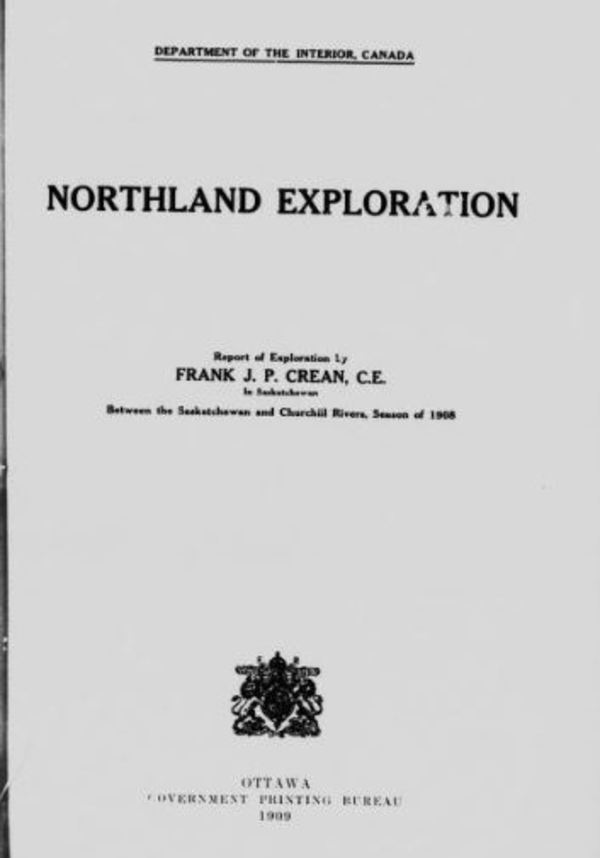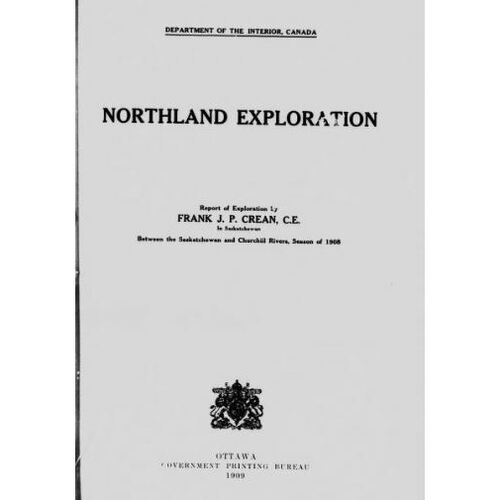
Source: Link
CREAN, FRANCIS JOSEPH PATRICK, timber-cruiser, civil engineer, civil servant, explorer, author, and army officer; b. 6 March 1875 in Dublin, son of Michael Theobald Crean (pronounced Crane) and Emma Dunne (Dunn); m. 19 Jan. 1909 Josephine Mary Gigot (d. 1963) in Nelson, B.C.; they had no children; d. 18 Dec. 1932 in Toronto.
Frank Crean’s father was a barrister who worked for the Irish Land Commission. The seventh of eight children, Frank attended two Roman Catholic schools, Belvedere College in Dublin and Clongowes Wood College in nearby Naas. Where he secured his engineering training is unclear; though he was not a member of Irish or English surveyors’ societies, he would later add C.E. to his name. In the South African War he served with Roberts’ Light Horse in 1899 and then with the 5th Canadian Mounted Rifles, but, in contrast to his highly decorated brother Thomas Joseph, little else is known about him at this time. It is uncertain why or when he emigrated to Canada, although he is remembered today by family as a black sheep. Over six feet tall, the heavyset, moustached Crean was an intimidating figure, all the more so because he sported a powder burn around his right eye and on his throat; Indians nicknamed him Big One Eye.
The earliest record of Crean’s Canadian activities is from 1903, when he was cruising timber 35 miles north of Prince Albert (Sask.) for the Bell Brothers Lumber Company. He apparently spent time in Winnipeg, for he claimed to be a friend of Hudson’s Bay Company commissioner Clarence Campbell Chipman* and he would later marry the eldest daughter of Édouard-François Gigot, the HBC’s manager in Nelson and a former Manitoba mla. It was probably through his western experience and contacts that Crean secured a position in Ottawa, from 4 Feb. 1908, as a clerk with the railway and swamplands branch of the federal Department of the Interior.
Crean joined the department at a time when its officials, worried that Canada was running out of land for homesteading, maintained that the area beyond the North Saskatchewan River would have to be opened. Indeed, it was being promoted as the “New Northwest.” Crean headed a small exploratory party to north-central Saskatchewan (the boreal forest south of the Churchill River) in the late summer of 1908 to determine its suitability for agricultural development. Although much of the land was gravelly, heavily timbered, or muskeg, he suggested that the weather was perfect for cereal crops and that wheat had been grown successfully wherever it had been planted. His report was illustrated with photographs he took during his travels. The splendid pictures of gardens and fields at missions and fur-trading posts – even though they were but a few acres in a vast land – seemed to be eloquent testimony to the area’s promise.
Crean’s confirmation landed him another expedition the following summer, into northeastern Alberta – as far north as the Clearwater River and west to the Athabasca. Once again he found the country to be ideal for the pioneer. In fact, he portrayed the region, with its wide range of natural resources, as being better suited for settlers of limited means than the open prairie to the south. He insisted that the most important obstacle to large-scale colonization was the lack of access, not the climate. His two expedition reports were published together under the title New Northwest exploration … (Ottawa, 1910).
In the end, Frank Crean’s conclusions could not stand up to scrutiny. Surveyors sent to the region north of Prince Albert in 1909 and 1910 to lay out major baselines, such as the third meridian, came across little land of agricultural value. Faced with these contradictory findings, in 1912 the Department of the Interior commissioned a special investigation that recommended the land be set aside as a federal forest reserve (Prince Albert National Park, established in 1927). Crean, for his part, resigned from his government post in February 1913 and found a position as an agent for Canada Life Assurance in Calgary before securing work with his brother-in-law in High River, Alta.
In January 1915, during World War I, he enlisted in the 12th Canadian Mounted Rifles Regiment in Calgary. He abruptly requested his discharge a month later. Commissioned a lieutenant in the militia (the 12th Manitoba Dragoons), he spent the remainder of the year at the internment camp for enemy aliens in Brandon, Man., before being removed from duty because of drunkenness. He then re-enlisted for overseas service and joined the 2nd Tunnelling Company of the Canadian Engineers in France in March 1916. His drinking, however, again interfered with his duties – his commanding officers politely described him as incompetent – and he was sent back to Canada in October. Upon debarkation, he continued his antics by failing to report, and he was not heard from for several months.
After the war, Crean returned briefly to Ottawa, presumably to find employment with his old department. He then relocated to Toronto and lived there, except for a time around 1928 when his wife ran a restaurant in Belle River. For the remainder of his life he drifted from job to job. At his death in 1932, the 57-year-old Crean was out of work. A Catholic, he was buried in Mount Hope Cemetery in Toronto by the Last Post Fund, a Montreal-based charity that arranged funerals for indigent veterans.
As for the New Northwest, it became a land of second chance in the interwar period. Over 200 new townships along the southern edge of the boreal forest were opened up to homesteaders, especially returning veterans, as part of a federal reconstruction program. During the Great Depression, many settlers abandoned their land in drought-stricken southern Saskatchewan and headed north to start over. Farming there, however, proved to be a difficult venture, and it could not support the kind of settlement envisaged by Crean.
The sources for this article can be found in the author’s New Northwest: the photographs of the Frank Crean expeditions, 1908–1909 (Saskatoon, 1993). Crean’s papers, including two albums of photographs, are held by SAB in Saskatoon (BF 26); there is also a slim collection at LAC, R190-36-2, file 1645827.
AO, RG 80-8-0-1331, no.7640.
Cite This Article
W. A. Waiser, “CREAN, FRANCIS JOSEPH PATRICK,” in Dictionary of Canadian Biography, vol. 16, University of Toronto/Université Laval, 2003–, accessed December 23, 2025, https://www.biographi.ca/en/bio/crean_francis_joseph_patrick_16E.html.
The citation above shows the format for footnotes and endnotes according to the Chicago manual of style (16th edition). Information to be used in other citation formats:
| Permalink: | https://www.biographi.ca/en/bio/crean_francis_joseph_patrick_16E.html |
| Author of Article: | W. A. Waiser |
| Title of Article: | CREAN, FRANCIS JOSEPH PATRICK |
| Publication Name: | Dictionary of Canadian Biography, vol. 16 |
| Publisher: | University of Toronto/Université Laval |
| Year of publication: | 2014 |
| Year of revision: | 2014 |
| Access Date: | December 23, 2025 |



